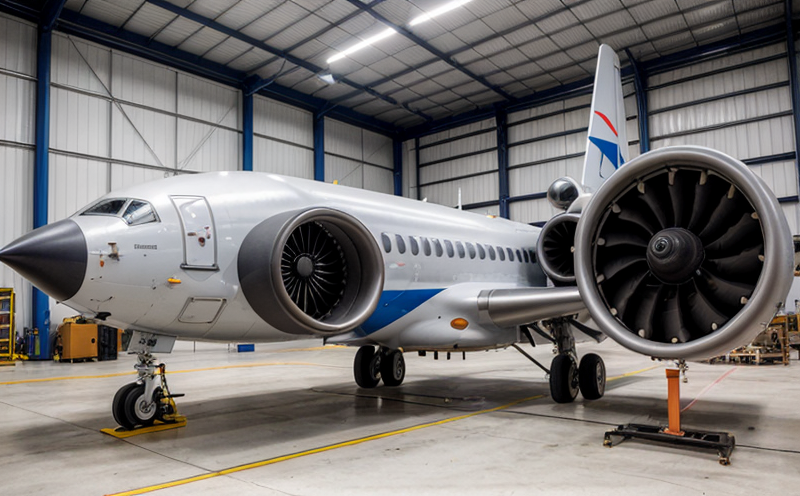Jet Intake Flow-Induced Vibration Testing
The aerospace and defense industries are characterized by high-performance requirements that demand rigorous testing to ensure safety, reliability, and efficiency. One critical aspect of this is the evaluation of jet intake flow-induced vibrations (FIV). These vibrations can arise due to the interaction between the airflow entering the engine and the structural components of the jet intake system. Understanding these interactions is essential for the design and operation of modern aerospace systems.
Flow-induced vibration testing plays a pivotal role in identifying potential structural issues that could lead to failure or reduced performance. This service involves subjecting the jet intake components to controlled airflow conditions, simulating real-world flight scenarios. The goal is to observe how these components respond under dynamic loading conditions and to assess their integrity.
The test setup typically includes a flow facility capable of generating high-speed airflows that mimic those experienced during flight. Specimens are mounted in the test rig, ensuring they replicate actual installation configurations. Sensors such as accelerometers and strain gauges are strategically placed on the components to measure vibrations and stress distributions accurately. The data collected is analyzed using advanced software tools to determine compliance with relevant standards like ISO 13952-4.
Compliance with these standards ensures that the tested products meet international quality benchmarks, which is crucial for regulatory approval and market entry. Additionally, this testing helps in optimizing design parameters, improving material selection, and enhancing manufacturing processes to minimize FIV effects. By identifying potential issues early in the development cycle, manufacturers can mitigate risks associated with operational environments.
Aerospace and defense systems are subject to extreme conditions that can exacerbate flow-induced vibrations. Thus, understanding these phenomena is vital for maintaining structural integrity over extended service lives. This testing not only addresses current challenges but also paves the way for future advancements in materials science and engineering practices.
Jet intake FIV testing is indispensable for ensuring the safety and performance of aircraft engines. It allows engineers to make informed decisions about design modifications, material choices, and manufacturing techniques based on empirical evidence rather than assumptions or theoretical models alone.
- Accurate Simulation: Real-world flight conditions are simulated accurately using state-of-the-art facilities.
- Data Accuracy: Precise measurements of vibrations and stresses ensure reliable results.
- Compliance Assurance: Testing aligns with international standards to guarantee regulatory compliance.
Why It Matters
The significance of jet intake flow-induced vibration testing cannot be overstated, especially in the aerospace and defense sectors. Flow-induced vibrations can lead to premature failures of critical components, which could result in catastrophic consequences during flight operations. By conducting comprehensive FIV tests, manufacturers can identify vulnerabilities early on, allowing for corrective actions before issues manifest into full-scale problems.
Understanding these vibrations is particularly important given the increasing complexity and performance demands placed on modern engines. As aircraft designs evolve to incorporate more advanced materials and configurations, the potential for flow-induced vibrations also increases. Therefore, thorough testing becomes a necessity rather than an option. This service provides valuable insights into how specific components behave under various conditions, enabling continuous improvement in product quality.
In addition to enhancing safety, FIV testing contributes significantly to reducing lifecycle costs by preventing costly repairs or replacements caused by unforeseen failures. It also supports the development of safer and more efficient aircraft systems, which is vital for both commercial airlines and military operations alike.
Benefits
The benefits of conducting jet intake flow-induced vibration testing are numerous and far-reaching. Primarily, it enhances product reliability by identifying and addressing potential weaknesses in the design or manufacturing process before they become operational issues. This proactive approach ensures that only robust components enter service, thereby reducing the risk of accidents.
Additionally, this testing facilitates compliance with stringent industry regulations and international standards such as ISO 13952-4, which govern the performance specifications for aerospace products. Meeting these standards not only opens doors to broader markets but also establishes a reputation for excellence among clients and stakeholders.
A more direct benefit lies in extended product life cycles. By understanding how components behave under dynamic loading conditions, manufacturers can implement targeted improvements that extend their service lives significantly. This longevity translates into substantial savings over the long term through reduced maintenance costs and fewer unscheduled downtimes.
From a strategic perspective, investing in FIV testing positions organizations at the forefront of technological innovation within the aerospace industry. It allows them to stay ahead of competitors by continuously refining their offerings based on cutting-edge research findings.





